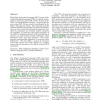375 search results - page 58 / 75 » Unified Modeling Language 2.0 |
DEXAW
2000
IEEE
14 years 1 months ago
2000
IEEE
Current models for cardinal directions, such as north and northeast, are either point-based or region-based, but no models exist that apply equally, independent of the geometric d...
ISORC
2000
IEEE
14 years 5 days ago
2000
IEEE
The Unified Modeling Language UML is well-suited for the design of real-time systems. In particular, the design of dynamic system behaviors is supported by interaction diagrams an...
ECMDAFA
2006
Springer
14 years 8 days ago
2006
Springer
Abstract. The Unified Modelling Language (UML) is intended to describe systems, but it is not clear what systems satisfy a given collection of UML diagrams. Stephen Mellor has desc...
PLILP
1992
Springer
14 years 20 days ago
1992
Springer
The unfold/fold framework constitutes the spine of many program transformation strategies. However, by unrestricted use of folding the target program may terminate less often than...
ACSC
2004
IEEE
14 years 10 days ago
2004
IEEE
The Object Constraint Language (OCL) is part of the Unified Modeling Language (UML) to specify restrictions on values of a given UML model. As part of the UML 2.0 standardization ...

